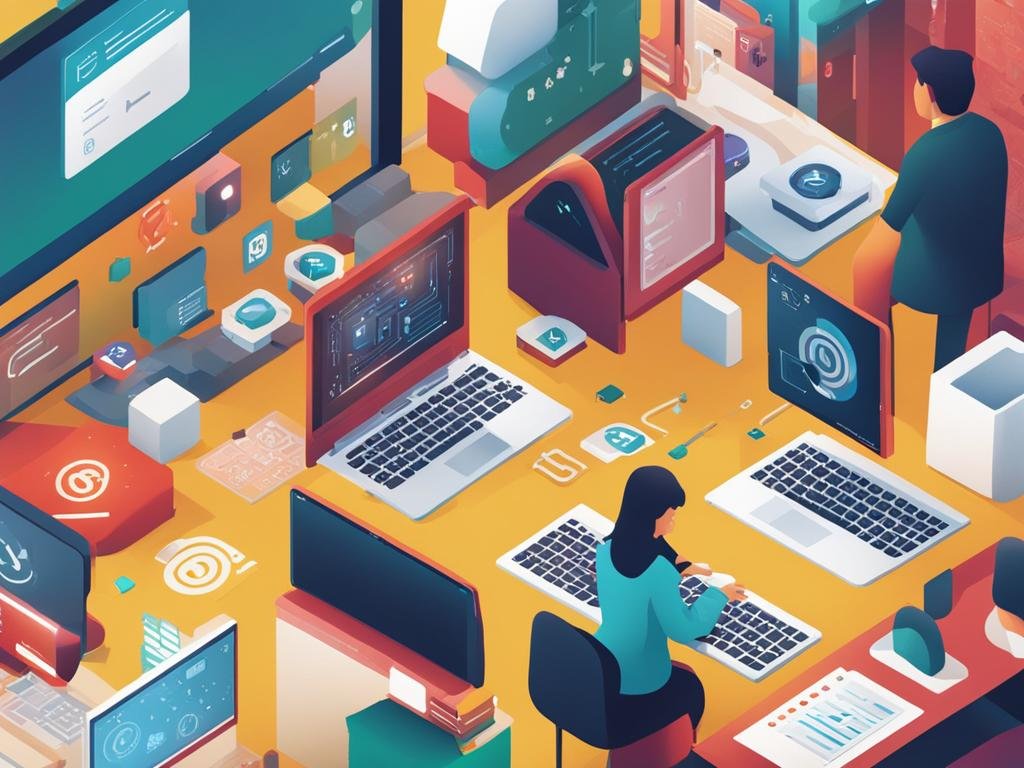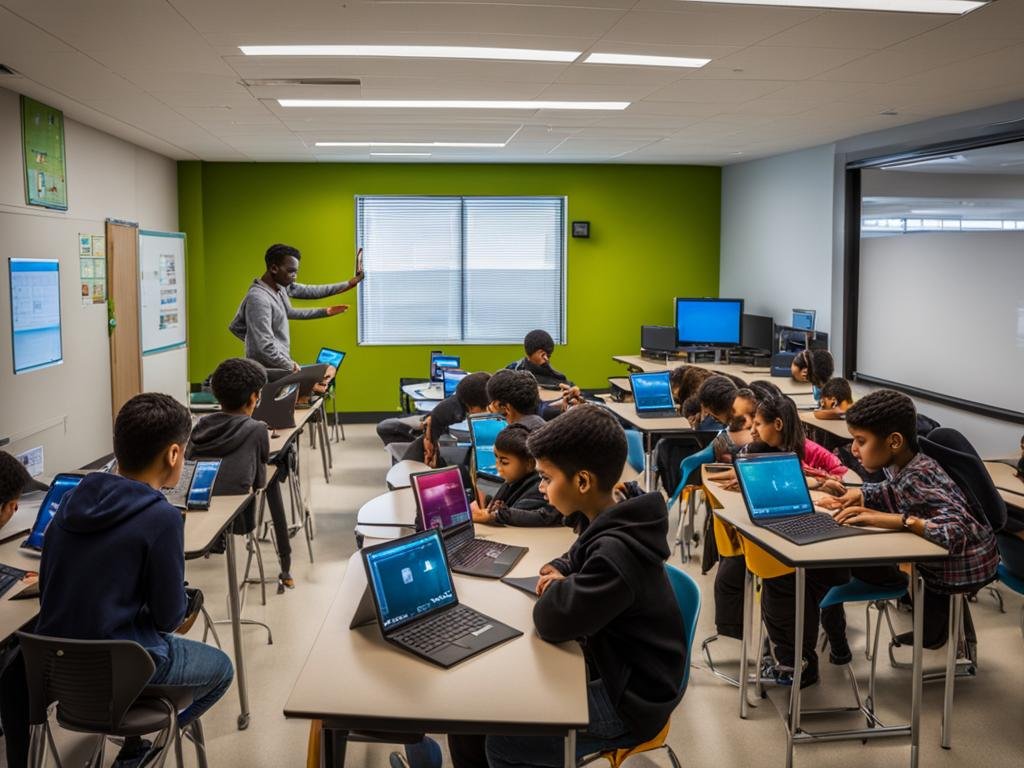Technological literacy is crucial in today’s digital world. It encompasses the ability to effectively use and understand digital tools and technologies. With the rapid advancement of technology, it is essential to develop digital skills and fluency to navigate the digital landscape confidently. By boosting technological literacy, individuals can enhance their opportunities and secure a brighter future.
Key Takeaways:
- Technological literacy is vital for success in today’s digital world.
- Developing digital skills and fluency is necessary to navigate the digital landscape.
- Boosting technological literacy enhances opportunities and secures a brighter future.
- Technology literacy encompasses the ability to effectively use and understand digital tools.
- Continuously updating technological literacy is crucial in a rapidly evolving digital world.
Understanding Technological Literacy
Technological literacy is a crucial skill in today’s digital age. It refers to the ability to use, design, and evaluate various digital technologies effectively. Technologically literate individuals possess the knowledge and proficiency to engage with technology as a valuable resource and effectively leverage it in different aspects of their lives.
One key aspect of technological literacy is the ability to use software and digital tools. This includes having the skills to navigate different software applications, such as word processors, spreadsheets, and presentation tools. Technologically literate individuals are able to effectively utilize these tools for various tasks, such as creating documents, analyzing data, and delivering impactful presentations.
In addition to software usage, communication skills are also crucial for technological literacy. This involves the ability to effectively communicate through digital platforms, such as email, messaging apps, and social media. Technologically literate individuals can navigate and leverage these platforms to connect with others, collaborate on projects, and share information.
| Key Components of Technological Literacy |
|---|
| Ability to use software and digital tools |
| Effective communication through digital platforms |
| Design and evaluation of digital technologies |
Furthermore, technological literacy involves the ability to design and evaluate digital technologies. This includes understanding the principles of user interface design, user experience, and interaction design. Technologically literate individuals can assess the usability and effectiveness of digital technologies, making informed decisions on which tools and resources to use for specific purposes.
In summary, technological literacy encompasses the ability to use software and digital tools, effectively communicate through digital platforms, and design and evaluate digital technologies. By cultivating these skills, individuals can navigate the digital world with confidence and utilize technology as a valuable resource in their personal and professional lives.
The Importance of Technological Literacy in Education
Educators play a crucial role in developing technological literacy among students. By incorporating technology into the curriculum, they can create meaningful learning experiences that prepare students for the increasingly digital world. Technology is no longer limited to a separate computer class; it should be integrated across subjects and grade levels.
Integrating technology in the classroom allows students to develop essential skills from a young age. It involves teaching them how to effectively evaluate and manage digital resources, collaborate with peers using various digital platforms, and troubleshoot technology-related issues. By involving students in interactive tasks that require the use of technology, educators can foster a technologically literate person who is equipped to thrive in today’s society.
Not only does technology enhance the learning process, but it also prepares students for future success in college and their careers. Higher education institutions emphasize the importance of technology skills and digital fluency in various fields of study. Being technologically literate gives students a competitive edge and empowers them to navigate the college environment, research and analyze information effectively, and communicate and collaborate using technology.
| Educational Benefits of Technological Literacy | Examples |
|---|---|
| Enhanced learning experiences | Interactive multimedia presentations |
| Improved research skills | Using online databases and academic resources |
| Collaborative learning | Online group projects and discussions |
| Preparation for future careers | Developing skills relevant to the workforce |
The Role of Educators
Educators have the responsibility to design and implement a curriculum that effectively integrates technology. This includes selecting appropriate digital tools and resources, providing guidance on responsible technology use, and staying updated with the latest technological trends. By actively embracing technology in the classroom, educators can empower students with the skills and knowledge needed to thrive in the digital age.
Building Digital Literacy Skills
Building digital literacy skills is essential in today’s technology-driven world. It involves developing the ability to effectively communicate, problem-solve, and understand and use technology in various contexts. Digital literacy encompasses a wide range of skills, including the ability to implement technology in everyday tasks, troubleshoot issues, refer to digital tools and platforms, and adapt to new technologies.
Having strong digital literacy skills allows individuals to navigate the digital landscape confidently and take advantage of the numerous opportunities it offers. It promotes efficient communication through various digital platforms, empowering individuals to effectively collaborate and share information.
Moreover, digital literacy enables individuals to solve complex tasks and problems by leveraging technology as a valuable tool. By understanding how to use digital tools effectively, individuals can enhance their productivity and overcome challenges more efficiently. Digital literacy also encompasses the ability to critically evaluate information from digital sources, ensuring accuracy and reliability.
To summarize, building digital literacy skills is crucial for individuals to thrive in today’s digital age. It equips them with the necessary knowledge and abilities to communicate, solve problems, and effectively use technology. By developing digital literacy skills, individuals can navigate the digital landscape confidently, leverage technology to their advantage, and become proficient users of digital tools and platforms.

Benefits of Building Digital Literacy Skills
- Enhanced communication through various digital platforms
- Improved problem-solving abilities through technology
- Increased productivity by leveraging digital tools effectively
- Awareness and evaluation of information from digital sources
- Adaptability to new technologies and digital advancements
“Technology is nothing. What’s important is that you have a faith in people, that they’re basically good and smart, and if you give them tools, they’ll do wonderful things with them.” – Steve Jobs
As Steve Jobs highlighted, technology is just a tool, and building digital literacy skills empowers individuals to do wonderful things with it. By focusing on enhancing digital literacy, individuals can unlock their potential and thrive in the ever-evolving digital world.
Staying Updated with Technological Trends
In today’s rapidly evolving digital world, staying updated with technological trends is crucial. The advancements in technology are transforming the way we live, work, and communicate. To effectively navigate this ever-changing landscape, it is essential to engage in discussions, collaborate with others, and stay informed about the latest technologies.
Technology is constantly evolving, and new technologies are being introduced at a rapid pace. By staying updated, individuals can adapt to these changes and harness the power of emerging technologies. This knowledge is not only valuable in personal life but also in professional settings, where the ability to operate and leverage new technologies can give individuals a competitive edge.
Staying updated with technological trends is particularly important in the field of education. As technology continues to reshape the way we learn and teach, educators and policymakers must remain informed about the latest advancements. This knowledge enables them to develop education policies that incorporate technology effectively and prepare students for the future. By embracing new technologies and fostering technological literacy in educational practices, we can ensure that students are equipped with the skills they need to thrive in the digital age.

Technological Trend Examples:
- Artificial Intelligence (AI) – AI is revolutionizing various industries, from healthcare to finance, by automating processes and delivering more personalized experiences.
- Internet of Things (IoT) – IoT enables devices to connect and communicate with each other, leading to smart homes, connected cars, and enhanced efficiency in various sectors.
- Blockchain Technology – Blockchain technology provides secure and transparent transactional systems, with applications ranging from cryptocurrency to supply chain management.
- Big Data Analytics – The ability to analyze large volumes of data is becoming increasingly important in decision-making processes across industries.
By staying updated with these technological trends and others, individuals can stay ahead of the curve and maximize the opportunities offered by new technologies. Through continuous learning and exploration, we can embrace the potential of technology and shape a smarter future.
Overcoming Barriers to Technological Literacy
Technological literacy is crucial in today’s digital world, but there are several barriers that hinder its development. Addressing these barriers is essential to ensure that individuals have the opportunity to enhance their digital skills and knowledge. By removing these obstacles, we can promote technological literacy and empower people to thrive in the digital age.
Barriers to Technological Literacy
One of the main barriers to technological literacy is the lack of clear criteria and assessment standards. Without a set criterion to measure proficiency, it becomes challenging to evaluate and promote technological literacy effectively. To overcome this barrier, it is crucial to establish clear guidelines that outline the skills and knowledge required to be technologically literate. These guidelines can serve as a roadmap for educators and learners, allowing them to track progress and ensure comprehensive comprehension of technology.
Another barrier is the lack of access to devices and resources. Inequitable access to technology can create a digital divide, where individuals with limited resources are unable to develop their technological literacy adequately. Bridging this gap requires initiatives that provide affordable or free access to devices and digital resources. By ensuring that everyone has the necessary tools, we can create a more inclusive digital society and promote technological literacy for all.
Overcoming Barriers through Promotion and Demonstration
One way to overcome barriers to technological literacy is through targeted promotion and demonstration. By highlighting the benefits and opportunities that come with being technologically literate, individuals are more likely to recognize the value of developing these skills. Promotional campaigns can showcase success stories of technologically literate individuals who have thrived in various fields, inspiring others to pursue technological literacy.
Demonstrations and hands-on experiences are also effective in overcoming barriers. Providing opportunities for individuals to engage with technology firsthand allows them to see its practical applications and build confidence in their abilities. By organizing workshops, interactive sessions, or online tutorials, we can create learning environments where individuals can experiment, explore, and apply their technological skills.
| Barrier | Solution |
|---|---|
| Lack of clear criteria and assessment standards | Establish clear guidelines for evaluating and promoting technological literacy |
| Lack of access to devices and resources | Provide affordable or free access to devices and digital resources |
| Lack of promotion and demonstration | Promote the benefits of technological literacy and provide hands-on experiences |

Overcoming barriers to technological literacy is crucial for individuals to navigate the digital world successfully. By addressing these barriers through clear criteria, equitable access, promotion, and demonstration, we can create an environment that fosters the development of technological skills and knowledge. By promoting technological literacy, we empower individuals to leverage technology effectively, opening up new opportunities and pathways for success.
The Connection Between Technology Literacy and Workforce Readiness
Technology literacy is closely connected to workforce readiness. In today’s workplace, the use of technology is pervasive, and employees need to be proficient in using various forms of technology. Whether it’s using software programs, operating machinery, or utilizing complex systems, technical skills are essential in many industries.
Moreover, the ability to adapt to new technologies and collaborate with others is highly valued in the modern workforce. As technology continues to advance at a rapid pace, staying up-to-date with new technologies and being able to effectively discuss and collaborate on technical matters are crucial skills. Employers seek individuals who can operate confidently in the digital realm and contribute to discussions on implementing new technologies in the workplace.
Education policy also plays a significant role in ensuring that individuals are technologically literate and prepared for the demands of the workforce. By incorporating technology into the curriculum and providing opportunities for students to engage in discussions and collaboration, educational institutions can foster the development of technology skills. This, in turn, enhances workforce readiness and equips individuals with the tools they need to succeed in a technology-driven world.
| Component | Importance in the Workplace |
|---|---|
| New Technologies | Continuous learning and adaptation to new tools and technologies |
| Discussion and Collaboration | Effective communication and teamwork in technology-related projects |
| Operate Various Forms of Technology | Proficiency in using diverse technology platforms and systems |
| Evaluation and Assessment | Ability to assess the performance and effectiveness of technology solutions |
| Educational Policy | Incorporating technology into curriculum and promoting technology literacy |
As the workplace continues to evolve, technology literacy will remain a critical component of workforce readiness. By recognizing the importance of technology skills and incorporating them into education policy, individuals can enhance their employability and contribute meaningfully to the success of businesses and organizations.
Empowering Individuals Through Technology Literacy
In today’s digital age, technology literacy is more important than ever. It empowers individuals to navigate the vast digital landscape, harness the power of technology, and secure a brighter future. By developing technology literacy, individuals can enhance their skills, become better problem solvers, and revolutionize the way they work, communicate, and interact.
One significant aspect of technology literacy is the ability to create impactful presentations. Whether it’s for a project, business pitch, or educational purposes, technology literacy allows individuals to utilize various tools and software to design visually engaging and informative presentations. By analyzing data, launching multimedia elements, and effectively communicating ideas, individuals can captivate their audience and convey their message with clarity and impact.
Another crucial component of technology literacy is the ability to locate and analyze information effectively. With a vast amount of information available online, individuals with strong technology literacy can navigate search engines, evaluate sources for accuracy and reliability, and extract relevant information to support their research and decision-making processes. This skill is particularly valuable in areas such as journalism, research, and other information-driven fields.

Technology literacy also includes the ability to enhance productivity and become better problem solvers. By leveraging digital tools and platforms, individuals can streamline their workflows, automate repetitive tasks, and collaborate with others seamlessly. Additionally, technology literacy fosters innovation and encourages individuals to think critically and creatively to overcome challenges and drive meaningful change in their respective fields.
Overall, technology literacy empowers individuals to maximize their potential in the digital age. It enables them to harness the power of technology, foster collaboration, and revolutionize the way they work, communicate, and interact. By investing in technology literacy, individuals can navigate the ever-evolving digital landscape with confidence and thrive in an increasingly interconnected world.
Overcoming the Challenges of Technological Advancement
Technological advancement is crucial in shaping society and driving transformation. In today’s increasingly digital world, machines and technology play a vital role in almost every aspect of our lives. However, with this rapid progress comes a set of challenges that individuals and society must overcome to fully harness the benefits of technology.
“Technology shapes society, and society shapes technology. It is a mutually influential relationship that has profound consequences.”
One of the main challenges is ensuring that technology remains reliable. As technology becomes increasingly important, it is crucial to develop a high level of trust in its reliability. This involves addressing concerns about data security, privacy, and ethical implications in the use of technology. Individuals and organizations must work together to build robust systems and frameworks that prioritize both innovation and accountability.
Moreover, the consequence of technological advancement is the need for individuals to develop the necessary skills and knowledge to thrive in a digital world. Technological literacy is not only crucial for personal advancement but also for economic growth and social inclusion. It enables individuals to navigate the complexities of technology, understand its implications, and adapt to continuous technological changes.
| Challenges | Solutions |
|---|---|
| Reliability concerns | Building robust systems, prioritizing data security and privacy, and ensuring ethical use of technology. |
| Developing necessary skills | Investing in technology education, promoting lifelong learning, and providing equal access to digital resources. |
| Addressing ethical implications | Encouraging meaningful discussions, fostering ethical frameworks, and promoting responsible use of technology. |
By acknowledging and addressing these challenges, individuals and society can harness the power of technological advancement for the greater good. It is crucial to foster an environment that promotes responsible use of technology, supports continuous learning, and ensures equal access to digital resources.

The Role of Education in Promoting Technological Literacy
Educational institutions play a vital role in promoting technological literacy by equipping students with the necessary skills and knowledge to effectively communicate, solve problems, and understand and utilize technology. In classrooms and colleges, educators focus on implementing technology to foster a deeper understanding of its applications and equip students with the ability to use technology as a tool for learning and growth.
Integrating Technology in the Classroom
Technological literacy starts in the classroom, where educators leverage various digital platforms and tools to enhance the learning experience. By incorporating technology, teachers can introduce interactive multimedia materials, facilitate collaborative projects, and provide real-world simulations that engage students in active learning. This hands-on approach to technology integration helps students develop a deeper understanding of technology and its role in their academic pursuits.
Preparing Students for College and Beyond
Colleges and universities also recognize the importance of technological literacy in preparing students for future success. As technology continues to shape various industries, being technologically literate becomes increasingly important. Higher education institutions prioritize equipping students with the skills needed to navigate digital resources effectively, conduct research, and communicate and collaborate using technology. By doing so, they ensure that graduates are ready to excel in a workforce that relies heavily on technology.
| Benefits of Technological Literacy in Education | Benefits of Technological Literacy in the Workplace |
|---|---|
| Enhances critical thinking and problem-solving skills | Empowers employees to adapt to new technologies |
| Facilitates collaboration and communication among students | Enables efficient use of digital tools and software |
| Provides access to a vast array of digital resources | Improves productivity and efficiency in the workplace |
| Prepares students for future college and career success | Fosters innovation and creativity in problem-solving |
By emphasizing technological literacy in education, schools and colleges empower students to become confident users of technology, preparing them for a future driven by digital innovation. The integration of technology in the classroom and the focus on developing technological literacy ensure that students are equipped with the necessary skills to succeed academically and in their future careers.

Also Read : Explore Your Future At Lawrence Technological University
Conclusion
Technological literacy is of utmost importance in today’s society, encompassing the skills and knowledge needed to navigate the digital world effectively. Whether you’re an engineer, a scientist, an educator, or simply someone seeking to enhance their understanding of technology, technological literacy is a crucial asset.
Incorporating technological literacy into the curriculum at a young age helps individuals develop the necessary skills to manage digital resources, solve problems, and communicate in today’s digital landscape. It enables students to engage with various digital platforms, troubleshoot issues, and refer to digital tools, fostering a comprehensive understanding of technology.
Moreover, technological literacy is not limited to the classroom. It extends to the workplace, where the ability to operate and collaborate with different forms of technology is increasingly important. By promoting technological literacy, education policies can ensure that individuals are equipped with the skills and knowledge needed to thrive in the modern workforce.
In conclusion, technological literacy is a vital component of our society, leading to the transformation and shaping of technology and vice versa. By fostering technological literacy, we can revolutionize the way we work, communicate, solve problems, and ensure a brighter future for all.
FAQs
Q: What does technological literacy mean?
A: Technological literacy refers to the ability to use information, understand scientific research, and solve problems related to technology. It involves learning about technology and its impact on society.
Q: How can one improve their technological literacy?
A: One can improve their technological literacy by staying updated with the latest technological advancements, reading relevant articles in newspapers and magazines, and utilizing facilities for learning and experimentation.
Q: Why is it important to boost technological literacy?
A: Boosting technological literacy is crucial for staying informed about new knowledge, understanding the impact of technology on society, and being able to adapt to the changing technological landscape.
Q: What are some ways to demonstrate technological literacy?
A: Demonstrating technological literacy can be achieved by actively participating in technology discussions, showcasing proficiency in using technological tools, and applying technological solutions to real-world problems.
Q: How can one stay informed about scientific research and technological advancements?
A: One can stay informed by regularly reading scientific journals, following reputable technology news websites, and attending conferences and seminars related to technological developments.
Q: What role do newspapers and magazines play in enhancing technological literacy?
A: Newspapers and magazines provide valuable insights into technological trends, innovations, and their impact on society, thus contributing to the enhancement of technological literacy.
Q: Can technological literacy help in career development?
A: Yes, technological literacy can significantly contribute to career development by enabling individuals to adapt to new technologies, communicate effectively in technical environments, and contribute to innovative solutions in their fields.
Q: How can educational institutions promote technological literacy?
A: Educational institutions can promote technological literacy by integrating technology into the curriculum, providing hands-on learning experiences, and encouraging students to explore and engage in scientific and technological activities.
Q: In what format can technological literacy be incorporated into educational programs?
A: Technological literacy can be incorporated through project-based learning, interactive workshops, and interdisciplinary activities that emphasize the practical application of technological knowledge.
Q: What are the benefits of enhancing technological literacy for individuals and society?
A: Enhancing technological literacy benefits individuals by improving problem-solving skills, increasing adaptability, and creating opportunities for personal and professional growth. For society, it leads to innovation, economic growth, and better-informed decision making.
Source Links
- https://issues.org/young-technological-techliteracy/
- https://www.forbes.com/sites/bernardmarr/2022/08/01/7-easy-ways-to-boost-your-digital-literacy/?sh=e06408e63536
- https://www.knowledgehut.com/blog/career/technology-literacy

